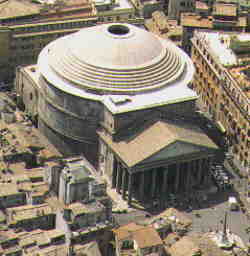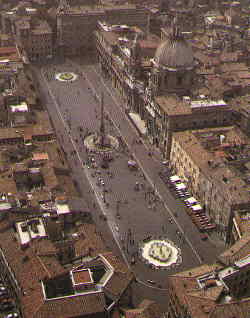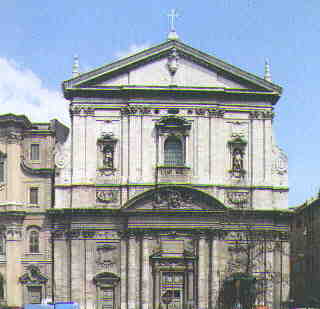Old Rome
The grandmother of all Rome's churches, Il Gesù, kicks off this tour. Take in the Baroque splendor -- notably, the spiraling ceiling frescoes -- then head out into the piazza. Cross Corso Vittorio and take Via del Gesù, turning left onto Via Piè di Marmo (literally, Street of the Marble Foot, named for the broken-off foot of what must have been a very large classical statue that was found here; the foot is at the corner of Via Santo Stefano del Cacco). Via Piè di Marmo leads into Piazza Santa Caterina di Siena and into Piazza della Minerva. On the right is the church of Santa Maria sopra Minerva, the only major church in Rome built in Gothic style -- it glitters and shines, so it was chosen for one of Andrea Bocelli's televised concerts -- and is famous as the home of Michelangelo's Risen Christ and frescoes by Filippino Lippi, some of the most beautiful Renaissance works in Rome. Right outside the church is the astounding 17th-century elephant memorial sculpted by Bernini.

Straight ahead is the curving, brick-bound mass of the Pantheon, one of the wonders of the ancient world and the most complete surviving building from antiquity. What you see is the side and rear of the building, where you can observe how the Romans built a series of weight-carrying arches into the walls of the building to support the huge dome, a technique later taken up by Renaissance architects. Follow Via della Minerva to Piazza della Rotonda and go to the north end of the square to get an overall view of the temple's columned portico. Inside, the oculus opens the ancient temple to the skies -- a great photo-op. Back out on the piazza you'll find a busy café scene that starts in the late morning and continues until late at night. Streets throughout this area are lined with gelaterias, pubs, pizzerias, restaurants, clubs, and discos.
Take Via degli Orfani north to Piazza Capranica and follow Via della Guglia into Piazza Montecitorio. Off the west side of the piazza, head into Via Uffizi del Vicario. Continue west on Via della Stelletta. Ahead of you, across Via della Scrofa, is Via dei Portoghesi and the picturesque Torre della Scimmia, the "Monkey Tower." More a piazza than a street, Via dei Portoghesi leads almost immediately into Via dell'Orso, lined with the shops of artisans, cabinetmakers, and antiques restorers. It ends at Via dei Soldati; climb the short flight of street stairs in front of the Hostaria dell'Orso, which has been serving guests since the 15th century, to see a museum devoted to the Italian-based branch of the French emperor, the Museo Napoleonico; inside, a group of salons conjure up all the red-velvet-crystal-chandelier charm of the 19th century. Highly conspicuous across the Tiber is the huge Palazzo di Giustizia (Court Building), a bombastic late-19th-century travertine marble monster.
Instead of heading south on heavily trafficked Via Zanardelli, go back down the street stairs and follow Via dei Soldati to Palazzo Altemps, renovated a decade ago to house a famous collection of classical antiquities. Piazza Navona is just across Piazza Sant'Apollonia, but you can save it for later. Instead, head east, under the arch, to the church of Sant'Agostino, which harbors a Caravaggio masterpiece. To see the most legendary Caravaggios, turn right on Via della Scrofa to reach Via della Dogana Vecchia and the church of San Luigi dei Francesi -- his three gigantic paintings devoted to the story of St. Matthew had the same effect on 17th-century art that Picasso's Demoiselles d'Avignon had on 20th-century painters. Continue south on Via della Dogana Vecchia to Piazza Sant'Eustachio, pausing to admire the bizarre pinnacle crowning the dome of Sant'Ivo alla Sapienza, which you can see from the piazza (the church's rear entrance is on the west side of Piazza Sant'Eustachio). Via del Salvatore skirts the flank of Palazzo Madama, Italy's Senate building, and leads to Corso Rinascimento. Go left on Corso Rinascimento to number 40, where you can get a frontal view of the church of Sant'Ivo alla Sapienza, considered the finest structure devised by Borromini, the second most famous Baroque architect after Bernini. The huge church looming at the end of Corso Rinascimento is Sant'Andrea della Valle, setting of the first act of Tosca. The slightly curved, columned facade on the north side of Corso Vittorio Emanuele is that of Palazzo Massimo alle Colonne, one of Rome's oldest patrician homes and still the residence of members of the Massimo family. On the south side of this major traffic artery is the Museo Barracco, a small collection of antiquities housed in a fine Renaissance building.

From Piazza San Pantaleo, Via della Cuccagna (Street of the Greased Pole, site of a favorite game) gives access to Piazza Navona, a celebrated 17th-century example of Baroque exuberance, with Bernini's Fontana dei Quattro Fiumi, or Fountain of the Four Rivers, as its centerpiece. This is easily Rome's most glorious piazza so be sure to grab a café table, order a gelato or lunch, and take in the spectacle. Flanking the piazza are Palazzo Pamphilj and the church of Sant'Agnese in Agone, whose Borromini facade is considered the quintessence of Roman Baroque.
From the west side of Piazza Navona, enter Via di Tor Millina and turn right at pretty Piazza della Pace. Narrow alleys curve around either side of the church of Santa Maria della Pace, set on a tiny piazzina and one of the city's cutest streetscapes. They lead to Via dei Coronari (Street of the Rosary Makers, where craftsmen fashion rosaries and wreaths for sacred images, a flourishing business in papal Rome). In addition, this attractive street is lined with art galleries and antiques shops. About halfway along Via dei Coronari is large Piazza San Salvatore in Lauro and on it the church of San Salvatore in Lauro. Continue west along Via dei Coronari to Via di Panico. Turn right and follow Via di Panico to Ponte Sant'Angelo and a good frontal view of Castel Sant'Angelo.
Next, turn left, away from the river, onto Via del Banco di Santo Spirito. On the right-hand side of this byway is an arched passageway, the Arco dei Banchi, entrance to Renaissance financier Agostino Chigi's counting rooms. A marble inscription on the left pillar of the arch says that the street was often flooded by the Tiber, a problem finally solved in the late 1800s when embankments were put up along the course of the river. In the pretty little edifice on the corner of Via dei Banchi Nuovi, Rome's oldest bank, the Banco di Santo Spirito (Bank of the Holy Spirit, now Banca di Roma), has operated since the early 1600s.
Cross Largo Tassoni to the west side of Corso Vittorio, where both Via del Consolato and Via dei Cimatori lead to the graceful church of San Giovanni dei Fiorentini, on Piazza dell'Oro (Gold Square), once the heart of Renaissance Rome's gold district. The interior of the church seems lifted from one of Raphael's paintings -- he once lived in this quarter -- and is imbued with 16th-century grace. One of Old Rome's most stately and historic streets, Via Giulia -- a Renaissance painting come to life -- begins at the south end of Piazza dell'Oro. It's lined with regal palaces and opulent antiques shops.

Stroll down Via Giulia, almost to the end, and take a left onto Via dei Farnese, which flanks the magisterial Palazzo Farnese -- once home to the hyperwealthy Farnese family, great Baroque art patrons -- and leads to the piazza of the same name. On the south side of Piazza Farnese, Via Capo di Ferro leads to Palazzo Spada, which houses a superb collection of paintings in gilded 17th-century salons. From Piazza della Quercia take Via dei Balestrari or Vicolo delle Grotte east to Campo de' Fiori (Field of Flowers), one of Rome's most colorful piazzas and home to the historic center's open-air market. North of Campo de' Fiori is the immense Palazzo della Cancelleria, headquarters of the Vatican's high court. Head northwest on Via del Pellegrino (the route pilgrims took to reach St. Peter's Basilica). Turn right onto Via Larga to reach busy Corso Vittorio Emanuele, dominated here by the huge Santa Maria in Vallicella and the Oratorio dei Filippini. To return to Piazza Navona, go east on Via del Governo Vecchio. The street takes its name from the 15th-century Palazzo Nardini, at No. 39, once seat of Rome's papal governors and later a law court.